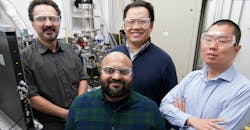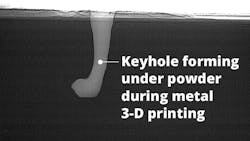Eliminating a 3D Printing Defect: Air Pockets
Additive manufacturing’s promise to revolutionize industry is constrained by at least one widespread problem: tiny gas pockets in the final product, which often leads to cracks and other failures.
Researchers from Carnegie Mellon University and the Energy Dept.’s Argonne National Lab have identified how and when these gas pockets form, as well as a methodology to predict their formation.
The air-pocket or keyhole phenomenon was viewed for the first-time using Argonne’s high-energy X-ray beam. The team used the extremely bright X-rays to take super-fast video and images of a 3D printing process called laser power bed fusion (LPBF), in which lasers melt and fuse metal powders.
The lasers, which scan each layer of powder to fuse metal where it is needed creates the finished product from the ground up. Defects form when pockets of gas are trapped in those layers, causing imperfections that lead to cracks and other breakdowns in the final product.
Until now, manufacturers and researchers did not know much about how the laser drills into the metal, producing cavities called “vapor depressions,” but they assumed the type of metal powder or strength of the laser were to blame. As a result, manufacturers have been using a trial-and-error approach with different types of metals and lasers in an effort to reduce the defects.
This image, taken under the synchrotron at Argonne National Laboratory, shows a keyhole void about to be formed during metal 3D printing. During laser powder bed fusion, a 3D printer “drills” a hole into the metal. (Courtesy: Carnegie Mellon University)
In fact, research shows that these vapor depressions exist under nearly all conditions in the process, no matter what laser or metal is used. Even more importantly, the research shows how to predict when small depressions will grow into larger and unstable ones that could create a defect.
Most people believe the laser in this process shines on the metal powder and is absorbed by the powder, which them melts the powder. In actuality, the laser drills a hole into the metal.
Under perfect conditions, the melt pool shape is shallow and semicircular, called the “conduction mode.” But during the actual printing process, the laser, often moving slowly, changes the melt pool shape to something like a keyhole: round and large on top, with a narrow spike at the bottom. Such “keyhole mode” melting can create defects in the final product.
Based on this finding, the researchers knew the keyhole phenomenon was more important than the powder being used.
The research shows that keyholes form when the laser power density is high enough to boil the metal. This, in turn, reveals the critical importance of the laser focus in additive manufacturing, a parameter that has received scant attention so far, according to the research team.
The experiment platform that supports study of additive manufacturing includes a laser apparatus, specialized detectors, and dedicated beamline instruments.
In 2016, the Argonne team, together with its research partners, captured the first-ever x-ray video of laser additive manufacturing at micrometer and microsecond scales. That study increased interest in the techniques and the kinds of problems that could be researched at Argonne’s APS.
The researchers believe their findings could motivate makers of 3D printers to offer more adjustments for controlling a machine’s laser. If their insights are acted on, 3D printing could also get faster.


